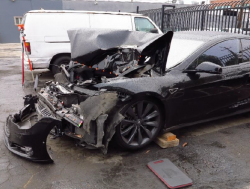— A Tesla Autopilot crash into a firetruck was primarily caused by the Tesla Model S P85 driver, although some blame is placed on the Autopilot system itself.
The January 22, 2018, Tesla crash into the firetruck occurred in Culver City, California as the Model S driver ignored the road.
The National Transportation Safety Board (NTSB) opened an investigation after driver Michael Tran, who was arrested for suspicion of driving under the influence, reported he thought he had the Autopilot system activated.
Autopilot includes the lane-keeping system Autosteer that can only be engaged after Traffic-Aware Cruise Control is activated. The Traffic-Aware Cruise Control is an adaptive cruise control system that modifies speed based on information from the camera and radar sensors.
Investigators didn't find evidence the driver was using his cell phone, but the driver told the NTSB he was drinking coffee and eating a bagel when the crash occurred.
The NTSB says the Culver City Fire Department truck with its emergency lights activated parked diagonally across the carpool lane on southbound Interstate 405 due to a previous collision.
Early reports said the Model S was traveling 65 mph when the car hit the firetruck, but the NTSB says the Tesla was traveling 31 mph behind another vehicle in the carpool lane when the lead vehicle changed lanes to the right as the Model S remained in the carpool lane.
The Tesla slammed into the rear of the firetruck when the driver didn't have his hands on the wheel and took no braking or steering evasive actions to avoid the firetruck.
According to the federal investigation, the Model S trip lasted about 66 minutes and Autopilot was engaged for about 29 minutes. However, the driver's hands were detected on the steering wheel only 78 seconds of the 29 minutes that Autopilot was engaged.
The NTSB notes the Model S owner's manual provides multiple warnings about the limitations of Autopilot and how drivers should keep their hands on the steering wheels at all times.
The driver was issued several warnings to get his hands on the wheel during the last 14 minutes before the crash, and the Autopilot system didn't detect his hands on the wheel in the last 3 minutes and 41 seconds.
Autopilot didn't detect the stationary firetruck until about half a second before the crash as the forward collision warning system activated which displayed a visual warning and an audio warning.
According to the NTSB report, the probable cause for the crash was the Tesla driver’s lack of response to the firetruck due to his inattention and overreliance on the Autopilot system. The driver was also blamed for using the system in ways contrary to Tesla's instructions and warnings.
But investigators found Tesla should shoulder some of the blame because the design of the Autopilot system permitted the driver to keep his hands off the wheel and his eyes off the road.
The California firetruck crash isn't the first where a Tesla driver crashed into a fire vehicle by depending on Autopilot to do all the work. Tesla was sued in 2018 for $300,000 after a Utah driver of a Model S crashed into a fire department vehicle as the Tesla driver looked at her cell phone.

